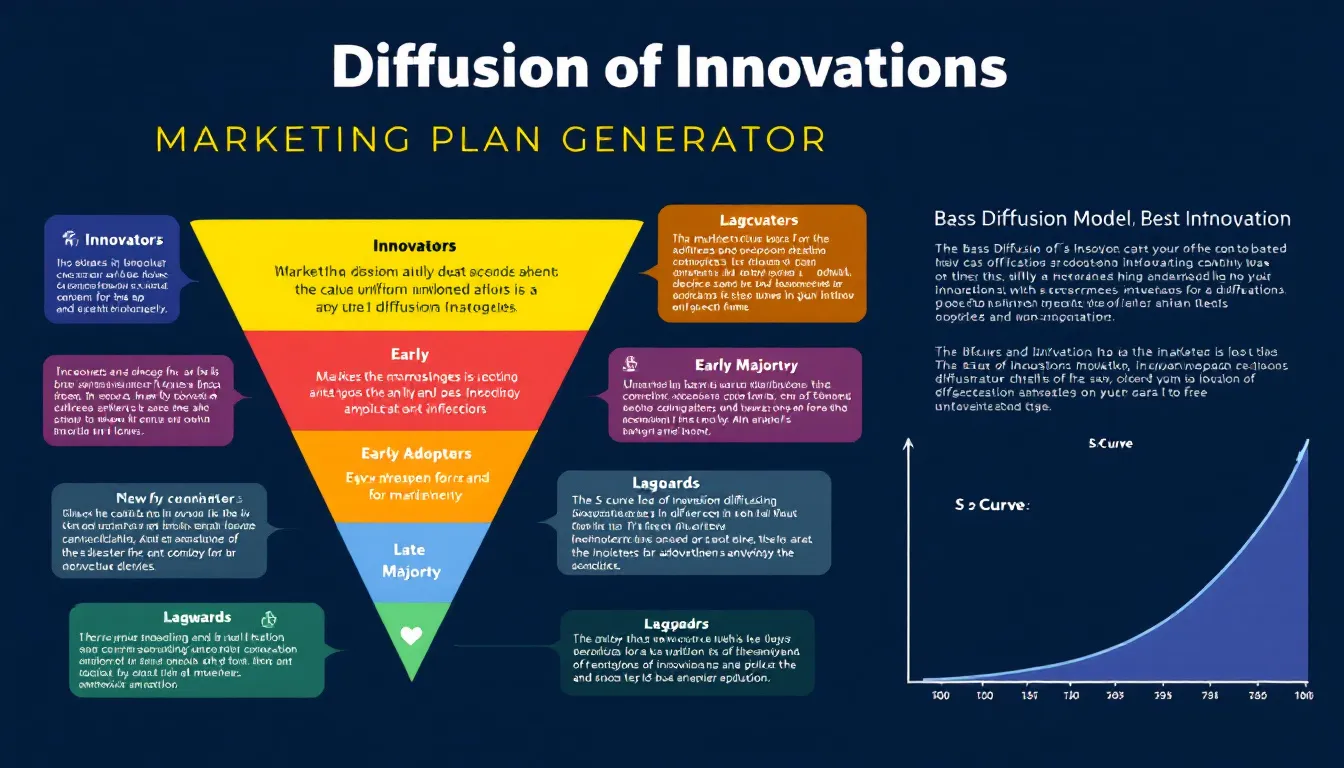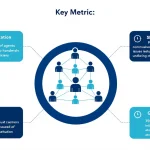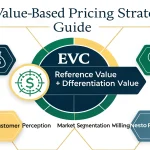Marketing Plan Generator
Is this tool helpful?
How to Use the Diffusion of Innovations Marketing Plan Generator Effectively
Step-by-Step Guide to Using the Tool
Follow these steps to generate a comprehensive marketing plan based on the Diffusion of Innovations theory:
- Enter the Product Name: Input the name of your product (e.g., “ChatGPT Queue”) in the designated field.
- Provide a Brief Product Description: In the text area, describe your product’s features and benefits. For example: “A Chrome extension that saves time by allowing users to queue messages for ChatGPT.”
- Specify the Pricing Structure: Enter your product’s pricing model (e.g., “One-time fee”).
- Input the Estimated Market Size (Optional): If known, enter the total number of potential users for your product. For instance, you might input “100000” if you estimate a market of 100,000 users.
- Generate the Marketing Plan: Click the “Generate Marketing Plan” button to process your inputs.
- Review the Results: The generated marketing plan will appear below the form, categorized into five sections corresponding to the adopter categories.
- Copy and Save: Use the “Copy to Clipboard” button to save your marketing plan for further use and customization.
Understanding the Diffusion of Innovations Marketing Plan Generator
What is the Diffusion of Innovations Marketing Plan Generator?
The Diffusion of Innovations Marketing Plan Generator is a sophisticated online tool designed to help marketers, entrepreneurs, and product managers create tailored marketing strategies based on the renowned Diffusion of Innovations theory. This theory, developed by Everett Rogers, explains how new ideas and technologies spread through different segments of a population over time.
Purpose and Benefits of the Tool
The primary purpose of this tool is to streamline the process of developing a comprehensive marketing plan that addresses the unique characteristics and needs of different adopter categories. By leveraging the principles of the Diffusion of Innovations theory, users can create more targeted and effective marketing strategies for their products or services.
Key Benefits:
- Time-saving: Quickly generate a structured marketing plan without extensive research.
- Theory-based approach: Utilize a well-established marketing theory to inform your strategies.
- Customized strategies: Receive tailored marketing approaches for each adopter category.
- Holistic perspective: Gain insights into the entire product adoption lifecycle.
- Improved resource allocation: Focus your marketing efforts more efficiently across different user segments.
Benefits of Using the Diffusion of Innovations Marketing Plan Generator
1. Strategic Marketing Alignment
By using this tool, marketers can align their strategies with the natural progression of product adoption. This alignment ensures that marketing efforts are more likely to resonate with each segment of the target audience at the right time, potentially increasing the overall effectiveness of the marketing campaign.
2. Enhanced Market Segmentation
The generator provides a clear breakdown of the market into five distinct adopter categories. This segmentation allows for more precise targeting and personalization of marketing messages, which can lead to higher engagement rates and better conversion across all stages of the product lifecycle.
3. Optimized Resource Allocation
With a clearer understanding of how different segments adopt new products, marketers can allocate their resources more efficiently. For instance, they might invest more heavily in influencer partnerships during the early adopter phase, while focusing on mass-market advertising for the early and late majority stages.
4. Improved Product Positioning
The tool helps marketers understand how to position their product differently for each adopter category. This insight can guide product development and feature prioritization, ensuring that the product evolves to meet the needs of different user segments over time.
5. Risk Mitigation
By considering the characteristics of each adopter category, marketers can anticipate potential challenges and objections at each stage of product adoption. This foresight allows for proactive strategy development, potentially reducing the risk of marketing campaign failure.
6. Long-term Planning Framework
The Diffusion of Innovations model provides a framework for long-term marketing planning. Marketers can use the generated plan as a roadmap for their product’s entire lifecycle, from initial launch to mass-market adoption and beyond.
How the Diffusion of Innovations Marketing Plan Generator Addresses User Needs
Tailored Marketing Strategies for Each Adopter Category
The generator provides specific marketing strategies for each of the five adopter categories identified in the Diffusion of Innovations theory. This tailored approach addresses the unique needs and characteristics of each group:
1. Innovators (2.5% of adopters)
For innovators, the tool might suggest strategies such as:
- Offering exclusive beta testing opportunities
- Highlighting cutting-edge features and technologies
- Engaging with tech-focused communities and forums
2. Early Adopters (13.5% of adopters)
Strategies for early adopters could include:
- Leveraging influencer partnerships
- Providing in-depth product demonstrations
- Creating case studies and success stories
3. Early Majority (34% of adopters)
For the early majority, the tool might recommend:
- Emphasizing social proof and user testimonials
- Offering free trials or money-back guarantees
- Focusing on user-friendly features and ease of integration
4. Late Majority (34% of adopters)
Strategies for the late majority could include:
- Highlighting widespread adoption and industry standards
- Offering competitive pricing or bundle deals
- Providing extensive customer support and training resources
5. Laggards (16% of adopters)
For laggards, the tool might suggest:
- Emphasizing the necessity of adoption
- Offering personalized onboarding and migration support
- Providing long-term value propositions and cost-saving analyses
Adoption Rate Calculation and Visualization
The tool incorporates the Bass Diffusion Model to predict adoption rates over time. This model is represented by the following equation:
$$f(t) = [p + q \times F(t)] \times [1 – F(t)]$$Where:
- $$f(t)$$ is the adoption rate at time $$t$$
- $$F(t)$$ is the cumulative adoption up to time $$t$$
- $$p$$ is the coefficient of innovation
- $$q$$ is the coefficient of imitation
The cumulative adoption function is given by:
$$F(t) = \frac{1 – e^{-(p+q)t}}{1 + \frac{q}{p}e^{-(p+q)t}}$$By applying these formulas, the tool can provide users with a visual representation of the expected adoption curve for their product, helping them to plan and adjust their marketing efforts over time.
Market Size Segmentation
When users input their estimated total market size, the tool automatically calculates the number of potential adopters in each category. For example, if a user enters a market size of 50,000 users, the tool would provide the following breakdown:
- Innovators: 50,000 × 0.025 = 1,250 users
- Early Adopters: 50,000 × 0.135 = 6,750 users
- Early Majority: 50,000 × 0.34 = 17,000 users
- Late Majority: 50,000 × 0.34 = 17,000 users
- Laggards: 50,000 × 0.16 = 8,000 users
This segmentation helps marketers understand the potential size of each adopter category and allocate resources accordingly.
Practical Applications and Use Cases
1. New Product Launch Strategy
Consider a startup launching a new productivity app. Using the Diffusion of Innovations Marketing Plan Generator, they might develop the following strategy:
- Innovators: Offer exclusive early access to tech bloggers and productivity enthusiasts.
- Early Adopters: Partner with productivity influencers for sponsored content and demos.
- Early Majority: Launch a referral program and showcase testimonials from early users.
- Late Majority: Introduce integration with popular tools and offer discounted team plans.
- Laggards: Provide comprehensive onboarding support and emphasize long-term productivity gains.
2. Technology Adoption in Education
An EdTech company introducing a new learning management system could use the tool to plan their marketing approach:
- Innovators: Pilot the system in tech-forward schools and educational conferences.
- Early Adopters: Showcase case studies from pilot schools and offer workshops for education leaders.
- Early Majority: Provide free trials for entire school districts and highlight ease of integration.
- Late Majority: Offer turnkey solutions including training and support for teachers and staff.
- Laggards: Emphasize compliance with educational standards and long-term cost savings.
3. Healthcare Innovation Diffusion
A company launching a new telemedicine platform might use the generator to create this strategy:
- Innovators: Partner with cutting-edge research hospitals for initial trials.
- Early Adopters: Showcase at medical conferences and offer early adopter discounts to private practices.
- Early Majority: Provide integration with popular electronic health record systems and patient testimonials.
- Late Majority: Offer comprehensive training programs and highlight industry-wide adoption trends.
- Laggards: Focus on regulatory compliance and long-term benefits to patient care and practice efficiency.
Frequently Asked Questions (FAQ)
Q1: How does the Diffusion of Innovations theory apply to modern digital products?
A1: The Diffusion of Innovations theory remains highly relevant for digital products. It helps predict and explain how users adopt new technologies over time, allowing marketers to tailor their strategies for different user segments. For digital products, the adoption curve may be accelerated, but the principles of different adopter categories still apply.
Q2: Can I customize the adopter category percentages?
A2: The current version of the tool uses the standard percentages from Rogers’ Diffusion of Innovations theory. However, future updates may include the option to customize these percentages based on specific industry data or user research.
Q3: How often should I update my marketing plan using this tool?
A3: It’s recommended to review and update your marketing plan regularly, especially as you move through different stages of product adoption. Consider revisiting the tool quarterly or whenever you have significant changes in your product features, target market, or competitive landscape.
Q4: Can this tool be used for services as well as products?
A4: Yes, the Diffusion of Innovations theory and this marketing plan generator can be applied to services as well as physical or digital products. The key is to consider how your service represents an innovation in your target market and tailor the strategies accordingly.
Q5: How does this tool account for different industry adoption rates?
A5: While the tool provides a general framework based on the Diffusion of Innovations theory, it’s important to consider industry-specific factors when implementing your marketing plan. Users should supplement the generated plan with industry research and adjust strategies based on known adoption patterns in their specific market.
Q6: Can I use this tool for planning a global product launch?
A6: The Diffusion of Innovations Marketing Plan Generator can be a valuable starting point for global product launches. However, it’s crucial to consider cultural differences, local market conditions, and varying adoption rates across different countries. Users may want to generate separate plans for key markets and adapt the strategies to local contexts.
Q7: How does the tool handle products with network effects?
A7: Products with network effects (where the value increases as more people use it) can experience accelerated adoption once they reach a critical mass. While the tool doesn’t explicitly account for network effects, users can incorporate this factor into their strategies, especially for the Early Majority and Late Majority categories, emphasizing the growing value proposition as adoption increases.
Q8: Can this tool help with pricing strategies across different adopter categories?
A8: While the tool doesn’t provide specific pricing recommendations, it can inform pricing strategies. For example, strategies for Innovators and Early Adopters might include premium pricing for exclusivity, while approaches for the Late Majority might involve more competitive pricing or bundle offers. Users should integrate these insights with their overall pricing strategy and market positioning.
Q9: How does the Bass Diffusion Model in the tool relate to real-world adoption rates?
A9: The Bass Diffusion Model provides a mathematical framework for estimating adoption over time. In the real world, actual adoption rates may vary due to numerous factors such as marketing effectiveness, competitive landscape, and unforeseen events. The model serves as a useful guide for planning, but users should monitor actual adoption rates and adjust their strategies accordingly.
Q10: Can I integrate the results from this tool with other marketing planning software?
A10: The marketing plan generated by this tool can be easily copied and integrated into other marketing planning software or documents. Users can copy the results to their clipboard and paste them into their preferred planning tools, allowing for further customization and integration with broader marketing strategies.
Important Disclaimer
The calculations, results, and content provided by our tools are not guaranteed to be accurate, complete, or reliable. Users are responsible for verifying and interpreting the results. Our content and tools may contain errors, biases, or inconsistencies. We reserve the right to save inputs and outputs from our tools for the purposes of error debugging, bias identification, and performance improvement. External companies providing AI models used in our tools may also save and process data in accordance with their own policies. By using our tools, you consent to this data collection and processing. We reserve the right to limit the usage of our tools based on current usability factors. By using our tools, you acknowledge that you have read, understood, and agreed to this disclaimer. You accept the inherent risks and limitations associated with the use of our tools and services.







